Micro-Computed Tomography with 3D Image Analysis to Reveal Firing Temperature Effects on Pore Systems in Archaeological and Ethnographic Ceramics
Abstract
Featured Application
Abstract
1. Introduction
2. Materials and Methods
2.1. Ceramic Sherds
2.2. Micro-CT Imaging
2.3. Protocols for 3D Image Analysis
- Intensity calibration of each micro-CT image at the outset brought the set of images closer to each other in intensity values with the goal of reducing the number of segmentation models that had to be developed by machine learning/deep learning; since then, some models worked well for multiple images.
- A Region of Interest (ROI) for each micro-CT image was created, selected to remove the background and to exclude any surface roughness area (Figure 2, left). Some of the ceramic samples also have a slip or a glaze layer, or both a glaze and a thin slip beneath it. These layers were excluded from the ROI since the purpose here is to characterize pores within the ceramic body itself.
- A segmentation model was developed that could separate the pore areas from the silica-rich particles and from the ceramic matrix. Since simple thresholding does not work well with these images, the Dragonfly tool for “segment with artificial intelligence” was used. Beginning with one slice, a large frame was created. Initial Otsu thresholding [68] was used to separate the image into the pore, silica particle, and matrix classes. Errors in that initial thresholding were corrected using a manual paintbrush tool. Several different machine learning and deep learning models were then trained using the data in the initial frame, as it is known that such models can improve the accuracy of segmentation when grey-level thresholding does not work well [49]. Once the models were trained, the results were viewed on a second slice, and the best-performing model used for further training, after additional manual corrections were applied with the paintbrush tool. Training followed by manual corrections continued until we had a model that gave good segmentation with no further corrections needed. We could usually stop after three slices; the maximum that was ever needed was five slices. The final fully trained model was then applied to the entire ROI (Figure 2, center). Individual models only needed to be developed about one-third of the time; initial intensity calibration of images meant that some models worked well for multiple images.
- The pore class was extracted from the segmentation result (Figure 2, right). It was processed to eliminate any speckling noise or other imaging artifacts. The total pore volume percentage was then calculated.
- The percentage of the pores that are accessible to any surface versus the percentage of inaccessible interior-only ones was calculated. This was carried out by overlaying a single-pixel-wide shell of the ROI and calculating what percentage of pores touch the shell in any slice (so are accessible to a surface) and what percentage do not (interior-only pores).
- A multi-ROI was created for the pores in each image by automatically grouping the voxels into components based on connectivity. Then, 16 statistical properties related to various shape and size parameters were calculated for the individual pores in each image. These variables were selected based on properties found to be significant in the previous brick micro-CT study [51].
- A sparse graph of pores was created for each image (Figure 3). This is a pore system model with spheres representing the pores and straight lines representing the connections between them (also called pore throats). These provided data primarily useful for quantitative connectivity data. Four variables were recorded: maximum and mean connectivity for the pores in each image, the connectivity standard deviation, and the percentage of pores that are completed isolated and unconnected to any other pores in the system.
- Additional data related to pore connections were obtained from a dense graph of pores. In this model, the lines connecting pores are more detailed and display all pixels connecting pores rather than having them reduced to a straight line. The dense graph also provides values for connection lengths and tortuosity (degree of indirectness of connection pathways) (Figure 4). Data for ten variables were obtained, all related to connectivity, tortuosity, and Euclidean length.
- The final eight variables were collected with a model created by OpenPNM, developed at University of Waterloo and available both as a stand-alone program (open source) [69] and in Dragonfly. This model is usually used to study complex issues of flow and permeability [70]. Here, we simply used it to collect data on the total number of edges and vertices in the pore systems and their ratio, the length and equivalent diameter of edges, and the equivalent diameter of vertices.
2.4. Data Analysis Procedures
3. Results
3.1. Pore Volume Percentages
3.2. Size and Shape Parameters from Pore Multi-ROIs
- Maximum pore volume (firing-temperature correlation 0.7);
- Pore surface area maximum and standard deviation (firing-temperature correlation 0.7 for both);
- Volume-to-surface area ratio, mean and standard deviation (firing-temperature correlation 0.9 and 0.7);
- Mean aspect ratio (firing-temperature correlation 0.8), for 3D defined as the proportional relationship between the smallest eigenvalue and the largest one (minimum/maximum);
- Mean Feret diameter, mean (mean of minimum and maximum distances between parallel tangents); and maximum Feret diameter, mean (firing-temperature correlation 0.8);
- Minimum orthogonal Feret diameter, mean (the shortest distance between two points along the boundary orthogonal to the maximum Feret diameter) (firing-temperature correlation 0.8);
- Minimum orthogonal/maximum Feret diameter, mean (this indicates pore elongation) (firing-temperature correlation 0.8).
3.3. Sparse Graphs of Pores, Connectivity
3.4. Dense Graphs
3.5. OpenPNM Pore Data
4. Discussion
5. Conclusions
Author Contributions
Funding
Institutional Review Board Statement
Informed Consent Statement
Data Availability Statement
Acknowledgments
Conflicts of Interest
References
- Rice, P.M. Pottery Analysis: A Sourcebook, 2nd ed.; The University of Chicago Press: Chicago, CA, USA, 2005. [Google Scholar]
- Tite, M.S. Determination of the firing temperature of ancient ceramics by measurement of thermal expansion: A reassessment. Archaeometry 2007, 11, 131–143. [Google Scholar] [CrossRef]
- Palmiter, T.V.; Johnson, P.F. Techniques for archaeothermometry. In Materials Issues in Art and Archaeology; Sayre, E.V., Vandiver, P., Druzik, J., Stevenson, C., Eds.; Materials Research Society: Pittsburgh, PA, USA, 1988; pp. 135–140. [Google Scholar]
- Hodges, H.W.M. The examination of ceramic materials in thin section. In The Scientist and the Archaeologist; Pyddock, E., Ed.; Roy: New York, NY, USA, 1963; pp. 101–110. [Google Scholar]
- Tite, M.S. Firing temperature determinations—How and why? In The Aim of Laboratory Analyses of Ceramics in Archaeology; Lindahl, A., Stilborg, O., Eds.; Almqvist and Wiksell International: Stockholm, Sweden, 1995; pp. 37–42. [Google Scholar]
- Santacreu, D.A. Materiality, Techniques and Society in Pottery Production; De Gruyter Open: Berlin, Germany, 2014. [Google Scholar]
- Maggetti, M. Phase analysis and its significance for technology and origin. In Archaeological Ceramics; Olin, J.S., Franklin, A.D., Eds.; Smithsonian Institution Press: Washington, DC, USA, 1982; pp. 121–133. [Google Scholar]
- Freestone, I.C.; Hughes, M.J. Appendix III: Examination of ceramics from Qasrij Cliff and Khirbet Qasrij. In Excavations at Qasrij Cliff and Khirbet Qasrij; Curtis, J., Collon, D., Eds.; British Museum: London, UK, 1989; pp. 61–75. [Google Scholar]
- González-Garcia, F.; Romero-Acosta, V.; García-Ramos, G.; González- García, M. Firing transformations of mixtures of clays containing illite, kaolinite and calcium carbonates used by ornamental tile industries. Appl. Clay Sci. 1990, 5, 361–375. [Google Scholar] [CrossRef]
- Echallier, J.C.; Mery, S. L’evolution mineralogique et physico-chimique des pates calcaires au cours de la caisson: Expérimentation en laboratoire et application archéologique. In Sciences de la Terre et Céramique Archéologiques: Experimentations, Applications, Documents et Travaux No. 16; Mery, S., Ed.; Centre Polytechnique Saint-Louis à Cercy: Cercy, France; pp. 87–120.
- Vaughn, S.J. Ceramic petrology and petrography in the Aegean. Am. J. Archaeol. 1995, 99, 115–117. [Google Scholar]
- Henderson, J. The Science and Archaeology of Materials; Routledge: London, UK, 2000. [Google Scholar]
- Chandler, G.M. Development of a Field Petrographic Analysis System and Its Application to the Study of Socioeconomic Interaction Networks of the Early Harappan Northwestern Indus Valley of Pakistan; British Archaeological Reports: Oxford, UK, 2001. [Google Scholar]
- Day, P.M.; Kilikoglou, V. Analysis of ceramics from the kiln. Hesperia Suppl. 2001, 30, 111–133. [Google Scholar] [CrossRef]
- Broekmans, T.; Adriaens, A.; Pantos, E. Insights into North Mesopotamian ‘metallic ware’. Archaeometry 2006, 48, 219–227. [Google Scholar] [CrossRef]
- Reedy, C.L. Thin-Section Petrography of Stone and Ceramic Cultural Materials; Archetype: London, UK, 2008. [Google Scholar]
- Allepuz, E.T. Colour transformation and texture change in biotite: Some remarks for the interpretation of firing technology in greyware pottery thin-sections. Minerals 2021, 11, 428. [Google Scholar] [CrossRef]
- Quinn, P.S. Thin Section Petrography Geochemistry & Scanning Electron Microscopy of Archaeological Ceramics; Archaeopress: Oxford, UK, 2022. [Google Scholar]
- Benetto, G.E.; Laviano, R.; Sabbatini, L.; Zambonin, P.G. Infrared spectroscopy in the mineralogical characterization of ancient pottery. J. Cult. Herit. 2002, 3, 177–186. [Google Scholar] [CrossRef]
- Kingery, W.D.; Vandiver, P.B. Ceramic Masterpieces: Art, Structure, and Technology; Free Press: New York, NY, USA, 1986. [Google Scholar]
- De Andres, A.M.; Balcazar, J.L. Study of ceramic sherds of Early Bronze Age shelters (Peña Corva, Guadalajara, Spain). In Archaeometry: Proceedings of the 25th International Symposium; Maniatis, Y., Ed.; Elsevier: Amsterdam, The Netherlands, 1989; pp. 593–601. [Google Scholar]
- Schneider, G. A technological study of North-Mesopotamian stoneware. World Archaeol. 1989, 21, 30–50. [Google Scholar] [CrossRef]
- Al-Saa’d, Z.; Roussan, A. Determination of the initial firing conditions of Ayyubid/Mamluk painted pottery excavated from northern Jordan. Geoarchaeology 1999, 14, 333–349. [Google Scholar] [CrossRef]
- Daszkiewicz, M.; Maritan, L. Experimental firing and re-firing. In The Oxford Handbook of Archaeological Ceramic Analysis; Hunt, A.M.W., Ed.; Oxford University Press: Oxford, UK, 2017; pp. 487–508. [Google Scholar]
- Reedy, C.L.; Vandiver, P.B.; He, T.; Xu, Y.; Wang, Y. Research into coal-clay composite ceramics of Sichuan Province, China. MRS Adv. 2017, 2, 2043–2079. [Google Scholar] [CrossRef]
- Reedy, C.L.; Vandiver, P.B.; He, T.; Xu, Y. Talc-rich black Tibetan pottery of Derge County, Sichuan Province, China. MRS Adv. 2017, 2, 1943–1968. [Google Scholar] [CrossRef]
- Trindade, M.J.; Dias, M.I.; Coroado, J.; Richa, F. Firing tests on clay-rich raw materials from the Algarve Basin (southern Portugal): Study of mineral transformations with temperature. Clay. Clay. Miner. 2010, 58, 188–204. [Google Scholar] [CrossRef]
- Rasmussen, K.L.; De La Fuente, G.A.; Bond, A.D.; Karshom Mathiesen, K.; Vera, S.D. Pottery firing temperatures: A new method for determining the firing temperature of ceramics and burnt clay. J. Archaeol. Sci. 2012, 39, 1705–1706. [Google Scholar] [CrossRef]
- Zhu, J.; Zhang, Y.; Wang, T.; Zhao, C.H.; Yu, J.C.; Glascock, M.D.; Wang, C.S. Determining the firing temperature of low-fired ancient pottery: An example from the Donghulin site, Beijing, China. Archaeometry 2014, 56, 562–572. [Google Scholar] [CrossRef]
- Maggetti, M.; Neururer, C.; Ramseyer, D. Temperature evolution inside a pot during experimental surface (bonfire) firing. Appl. Clay Sci. 2011, 53, 500–508. [Google Scholar] [CrossRef]
- Heinsch, M.F.; Vandiver, P.B.; Lyublyanovics, K.; Choyke, A.M.; Reedy, C.; Tourtellotte, P.; Chang, C. Ceramics at the emergence of the Silk Road: A case of village potters from southeastern Kazakhstan during the Late Iron Age. Mater. Res. Soc. Symp. Proc. 2015, 1656, 251–281. [Google Scholar] [CrossRef]
- Rye, O.S. Keeping your temper under control: Materials and the manufacture of Papuan pottery. APAO 1976, 9, 106–137. [Google Scholar]
- Park, K.S.; Milke, R.; Rybacki, E.; Reinhold, S. Application of image analysis for the identification of prehistoric ceramic production technologies in the North Caucasus (Russia, Bronze/Iron Age). Heritage 2019, 2, 2327–2342. [Google Scholar] [CrossRef]
- Morariu, V.V.; Bogdan, M.; Ardelean, I. Ancient pottery: Its pore structure. Archaeometry 1977, 19, 187–221. [Google Scholar] [CrossRef]
- Koh Choo, C.K.; Lee, Y.E.; Shim, I.W.; Choo, W.K.; Kim, G.H.; Huh, W.Y.; Chun, S.C. Compositional and microstructural study of Koryŏ celadon and whiteware excavated from Sŏri kiln in Kyŏnggi province. Archaeometry 2004, 46, 247–265. [Google Scholar] [CrossRef]
- Harry, G.K.; Johnson, A. A non-destructive technique for measuring ceramic porosity using liquid nitrogen. J. Archaeol. Sci. 2004, 31, 1567–1575. [Google Scholar] [CrossRef]
- Freyburg, S.; Schwarz, A. Influence of the clay type on the pore structure of structural ceramics. J. Eur. Ceram. Soc. 2006, 27, 1727–1733. [Google Scholar] [CrossRef]
- Coletti, C.; Cultrone, G.; Maritan, L.; Mazzoli, C. Combined multi-analytical approach for study of pore system in bricks: How much porosity is there? Mater. Charact. 2016, 121, 82–92. [Google Scholar] [CrossRef]
- Delbrouck, O.; Janssen, J.; Ottenburgs, R.; Van Oyen, P.; Viaene, W. Evolution of porosity in extruded stoneware as a function of firing temperature. Appl. Clay Sci 1993, 8, 187–192. [Google Scholar] [CrossRef]
- Ricci, G. Archaeometric Studies of Historical Ceramic Materials. Ph.D. Thesis, Università Ca’ Foscari, Venezia, Italy, 2016. Available online: http://dspace.unive.it/bitstream/handle/10579/10321/956083-1186678.pdf?sequence=2 (accessed on 7 November 2022).
- Dunsmuir, J.H.; Vandiver, P.B.; Chianelli, R.R.; Deckman, H.W.; Hardenberg, J.H. X-ray microtomography of ceramic artifacts. In Materials Issues in Art and Archeology IV; Vandiver, P.B., Druzik, J.R., Galvin Madrid, J.L., Freestone, I.C., Wheeler, G.S., Eds.; Materials Research Society: Pittsburgh, PA, USA, 1995; pp. 73–83. [Google Scholar]
- Kahl, W.-A.; Ramminger, B. Non-destructive fabric analysis of prehistoric pottery using high-resolution X-ray microtomography. J. Archeol. Sci. 2012, 39, 2206–2212. [Google Scholar] [CrossRef]
- Sobott, R.; Bente, K.; Kittel, M. Comparative porosity measurements on ceramic materials. Old Potter’s Almanack 2014, 19, 18–25. [Google Scholar]
- Sanger, M.C. Investigating pottery vessel manufacturing techniques using radiographic imaging and computed tomography: Studies from the Late Archaic American Southwest. J. Archaeol. Sci. Rep. 2016, 9, 586–598. [Google Scholar] [CrossRef]
- Gomart, L.; Weiner, A.; Gabriele, M.; Durrenmath, G.; Sorin, S.; Angeli, L.; Colombo, M.; Fabbri, C.; Maggi, R.; Panelli, C.; et al. Spiralled patchwork in pottery manufacture and the introduction of farming to Southern Europe. Antiquity 2017, 91, 1501–1514. [Google Scholar] [CrossRef]
- Kozatsas, J.; Kotsakis, K.; Sagris, D.; David, K. Inside out: Assessing pottery forming techniques with micro-CT scanning. J. Archaeol. Sci. 2018, 100, 102–119. [Google Scholar] [CrossRef]
- Bernardini, F.; Leghissa, E.; Prokop, D.; Velušček, A.; De Min, A.; Dreossi, D.; Donato, S.; Tuniz, C.; Princivalle, F.; Montagnari Kokelj, M. X-ray computed tomography of Late Copper Age decorated bowls with cross-shaped foots from central Slovenia and the Trieste Karst (North-Eastern Italy): Technology and paste characterization. Archaeol. Anthropol. Sci. 2019, 11, 4711–4728. [Google Scholar] [CrossRef]
- St. John, A. Inside Perspectives on Ceramic Manufacturing: Visualizing Ancient Potting Practices through Micro-CT Scanning. Ph.D. Thesis, University of Western Ontario, Ontario, ON, Canada, 2020. Available online: https://ir.lib.uwo.ca/etd/7502/ (accessed on 7 November 2022).
- Nickerson, S.; Shu, Y.; Zhong, D.; Könke, C.; Tandia, A. Permeability of porous ceramics by X-ray CT image analysis. Acta Mater. 2019, 172, 121–130. [Google Scholar] [CrossRef]
- Buchner, T.; Kiefer, T.; Zelya-Lainez, L.; Gaggi, W.; Konegger, T. A multitechnique quantitative characterization of the pore space of fired bricks made of the five clayey raw materials used in European brick industry. Appl. Clay Sci. 2021, 200, 105884. [Google Scholar] [CrossRef]
- Reedy, C.L.; Reedy, C.L. High-resolution micro-CT with 3D image analysis for porosity characterization of historic bricks. Herit. Sci. 2022, 10, 83. [Google Scholar] [CrossRef]
- Du Plessis, A.; Babatunde, J.O.; Boshoff, W.P.; le Roux, S.G. Simple and fast porosity analysis of concrete using X-ray computed tomography. Mater. Struct. 2016, 49, 553–562. [Google Scholar] [CrossRef]
- Stark, M. The chronology, technology and contexts of earthenware ceramics in Cambodia. In Earthenware in Southeast Asia; Miksic, J.N., Ed.; Singapore University Press: Singapore, 2003; pp. 208–229. [Google Scholar]
- Ea, D. Angkorian kilns in mainland South East Asia. South East Asian Rev. 2009, 34, 1–50. [Google Scholar]
- Marriner, G.P.; Grave, P.; Kealhofer, L.; Stark, M.T.; Ea, D.; Chhay, R.; Kaseka, P.; Boun Suy, T. New dates for old kilns: A revised radiocarbon chronology of stoneware production for Angkorian Cambodia. Radiocarbon 2018, 60, 901–924. [Google Scholar] [CrossRef]
- Thirion-Merle, V.; Desbat, A.; Thierrin-Michael, G.; Hong, R. The kiln sites of the “Torp Chey” area (Cambodia). Bull. De l’ÉCole Française d’ExtrĚMe-Orient 2020, 106, 195–224. [Google Scholar] [CrossRef]
- Rawson, J.; Tite, M.S.; Hughes, M.J. The export of Tang Sancai wares: Some recent research. TOCS 1989, 52, 39–61. [Google Scholar]
- Kerr, R.; Wood, N. Science and Civilization in China. Vol. 5, Chemistry and Chemical Technology, Part XII: Ceramic Technology; Cambridge University Press: Cambridge, UK, 2004; pp. 474–488. [Google Scholar]
- Jiang, Q. Tang Sancai. Ph.D. Thesis, University of Oxford, Oxford, UK, 2009. [Google Scholar]
- Cui, J.; Rehren, T.; Lei, Y.; Cheng, X.; Jiang, J.; Wu, X. Western technical traditions of pottery making in Tang Dynasty China: Chemical evidence from the Liquanfang Kiln site, Xi’an city. J. Archaeol. Sci. 2010, 37, 1502–1509. [Google Scholar] [CrossRef]
- Reedy, C.L.; Kivi, N.J.; Vandiver, P.B. Technological achievements of the Xiba Kiln of Leshan City, Sichuan Province. In 2018 International Symposium on Ancient Ceramics —It’s Scientific and Technological Insights; Chen, S., Ed.; Shanghai Institute of Ceramics, Chinese Academy of Sciences: Shanghai, China, 2018; pp. 68–77. [Google Scholar]
- Li, W.; Luo, H.; Li, J.; Lu, X.; Guo, J. The white porcelains from Dehua kiln site of China: Part II: Microstructure and its physicochemical basis. Ceram. Int. 2011, 37, 651–658. [Google Scholar] [CrossRef]
- Vandiver, P.B. Variability of Song Dynasty green glaze technology using microstructure, microcomposition and thermal history to compare Yaozhou, Jun, Ru, Yue, Longquan, Guan, and Korean Koryo Dynasty materials and practices. In Proceedings of International Symposium on Science and Technology of Five Great Wares of the Song Dynasty; Shi, N., Miao, J., Eds.; Science Press: Beijing, China, 2016; pp. 391–432. [Google Scholar]
- Rastelli, S. The Yaozhou Kilns: A Re-Evaluation. Ph.D. Thesis, School of Oriental and African Studies, University of London, London, UK, 2017. [Google Scholar]
- Huang, S.; Freestone, I.C.; Zhu, Y.; Shen, L. The introduction of celadon production in North China: Technological characteristics and diversity of the earliest wares. J. Archaeol. Sci. 2020, 114, 105057. [Google Scholar] [CrossRef]
- Bugani, S.; Camaiti, M.; Morselli, L.; Van de Casteele, E.; Janssens, K. Investigation on porosity changes of Lecce stone due to conservation treatments by means of X-ray nano- and improved micro-computed tomography: Preliminary results. X-ray Spectrom. 2007, 36, 316–320. [Google Scholar] [CrossRef]
- Object Research Systems. Available online: http://www.theobjects.com/company/index.html (accessed on 15 September 2022).
- Otsu, N. A threshold selection method from gray-level histograms. IEEE Trans. Man. Cybern. 1979, 9, 62–66. [Google Scholar] [CrossRef]
- Gostick, J.; Aghighi, M.; Hinebaugh, J.; Tranter, T.; Hoeh, M.A.; Day, H.; Spellacy, B.; Sharqawy, M.H.; Bazylak, A.; Burns, A.; et al. OpenPNM: A pore network modeling package. Comput. Sci. Eng. 2016, 18, 60–74. [Google Scholar] [CrossRef]
- Munawar, M.J.; Lin, C.; Cnudde, V.; Bultreys, T.; Dong, C.; Zhang, X.; De Boever, W.; Zahid, M.A. Petrographic characterization to build an accurate rock model using micro-CT: Case study on low-permeable to tight turbidity sandstone from Eocene Shahejie Formation. Micron 2018, 109, 22–33. [Google Scholar] [CrossRef] [PubMed]
- Stefanidou, M.A. Assimilation of porosity in modern bricks by computational means. WIT Trans. Eng. Sci. 2007, 57, 313–318. [Google Scholar]
- Reedy, C.L. Incorporating image analysis into ceramic thin-section petrography. In Twenty-Year Retrospective of National Center for Preservation Technology and Training Sponsored Archeology; Britt, T., Ed.; National Center for Preservation Technology and Training: Natchitoches, LA, USA, 2017; pp. 47–54. [Google Scholar]
- Cultrone, G.; Sebastián, E.; Elert, K.; de la Torre, M.J.; Cazalla, O.; Rodriguez-Navarro, C. Influence of mineralogy and firing temperature on the porosity of bricks. J. Eur. Ceramic. Soc. 2004, 24, 547–564. [Google Scholar] [CrossRef]
- Vandiver, P.B.; Koehler, C.G. Structure, processing, properties, and style of Corinthian transport amphoras. In Technology and Style; Kingery, W.D., Ed.; The American Ceramic Society, Inc.: Columbus, OH, USA, 1986; pp. 173–215. [Google Scholar]
- Klobes, P.; Meyer, K.; Murro, R.G. Porosity and Specific Surface Area Measurements for Solid Materials. NIST Special Publication 960–17; National Institute of Standards and Technology: Washington, DC, USA, 2006. [Google Scholar]
- Grubeša, I.N.; Vračevič, M.; Ducman, V.; Marković, B.; Szenti, I.; Kukovecz, Á. Influence of the size and type of pores on brick resistance to freeze-thaw cycles. Materials 2020, 13, 3717. [Google Scholar] [CrossRef]
- Borelli, E. Porosity; ICCROM: Rome, Italy, 1999. [Google Scholar]
- Gavilán, A.B.R.; Esteban, M.A.R.; Iglesias, M.N.A.; Perez, M.P.S.; Olea, M.S.C.; Valdizán, J.C. Experimental study of the mechanical behaviour of bricks from 19th and 20th century buildings in the province of Zamora (Spain). Infrastructures 2018, 3, 38. [Google Scholar] [CrossRef]
- Studart, A.R.; Gonzenback, U.T.; Tervoort, E.; Gauckler, L.J. Processing routes to microporous ceramics: A review. J. A, Ceram. Soc. 2006, 89, 1771–1789. [Google Scholar] [CrossRef]
- Orts, M.J.; Escardino, A.; Amorós, J.L.; Negre, F. Microstructural changes during the firing of stoneware floor tiles. Appl. Clay Sci. 1993, 8, 193–225. [Google Scholar] [CrossRef]
- Kariem, H.; Hellmich, C.; Kiefer, T.; Jäger, A.; Füssi, J. Micro-CT-based identification of double porosity in fired clay objects. J. Mater. Sci. 2018, 53, 9411–9428. [Google Scholar] [CrossRef]
- Haruzi, P.; Katsman, R.; Halisch, M.; Waldmann, N.; Spiron, B. Benchmark study using a multi-scale, multi-methodological approach for the petrophysical characterization of reservoir sandstones. Solid Earth 2021, 12, 665–689. [Google Scholar] [CrossRef]
- Puskarczyk, E.; Krakowska, P.; Jedrychowski, M.; Habrat, M.; Madejski, P. A novel approach to the quantitative interpretation of petrophysical parameters using nano-CT: Example of Paleozoic carbonates. Acta Geophys. 2018, 66, 1453–1461. [Google Scholar] [CrossRef]
- Thomson, P.-R.; Aituar-Zhakupova, A.; Hier-Majumder, S. Image segmentation and analysis of pore network geometry in two natural sandstones. Front. Earth Sci. 2018, 6, 58. [Google Scholar] [CrossRef]
- Liu, H.; Ma, C.; Zhu, C. X-ray micro CT based characterization of pore-throat network for marine carbonates from South China Sea. Appl. Sci. 2022, 12, 2611. [Google Scholar] [CrossRef]
- López-Arce, P.; Zornoza-Indart, A.; Gomez-Villalba, L.; Pérez-Monserrat, E.M.; Alvarez de Buergo, M.; Vivar, G.; Fort, R. Archaeological ceramics amphorae from underwater marine environments: Influence of firing temperature on salt crystallization decay. J. Eur. Ceram. Soc. 2013, 33, 2031–2042. [Google Scholar] [CrossRef]
- Porous Microstructure Analysis (PuMA). Available online: https://software.nasa.gov/software/ARC-17920-1A (accessed on 29 September 2022).
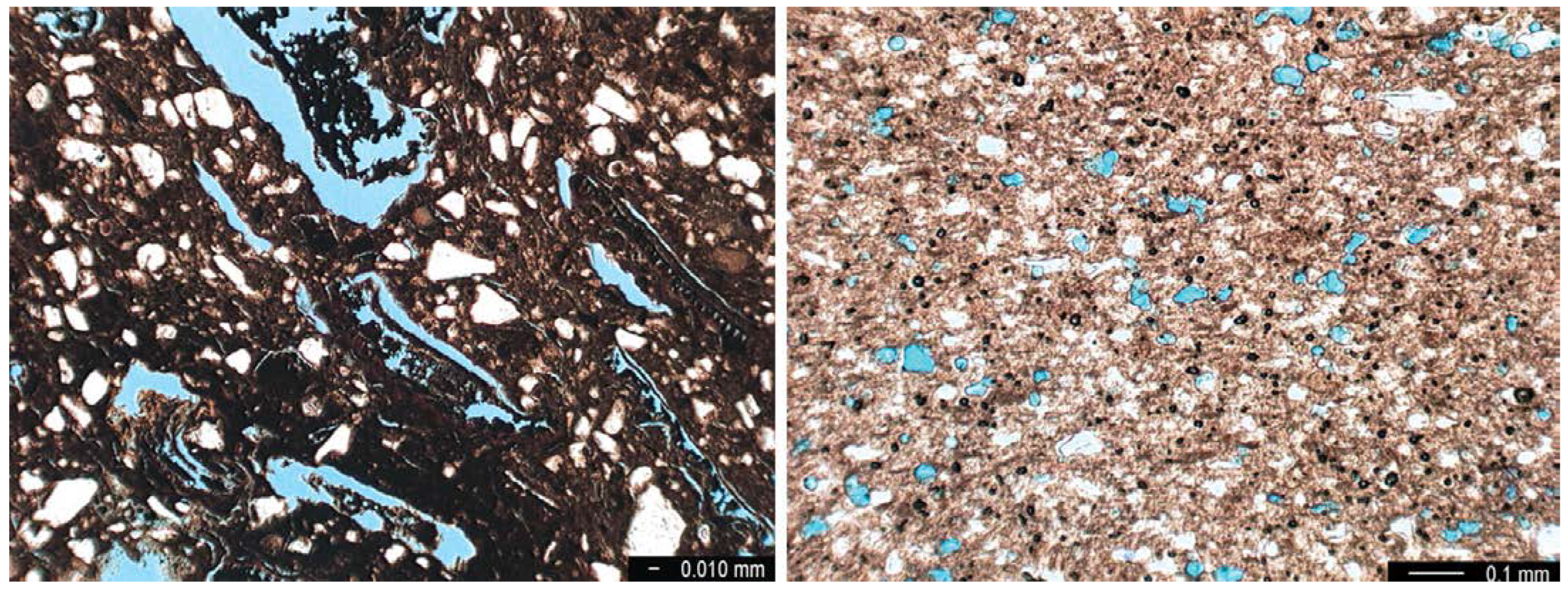
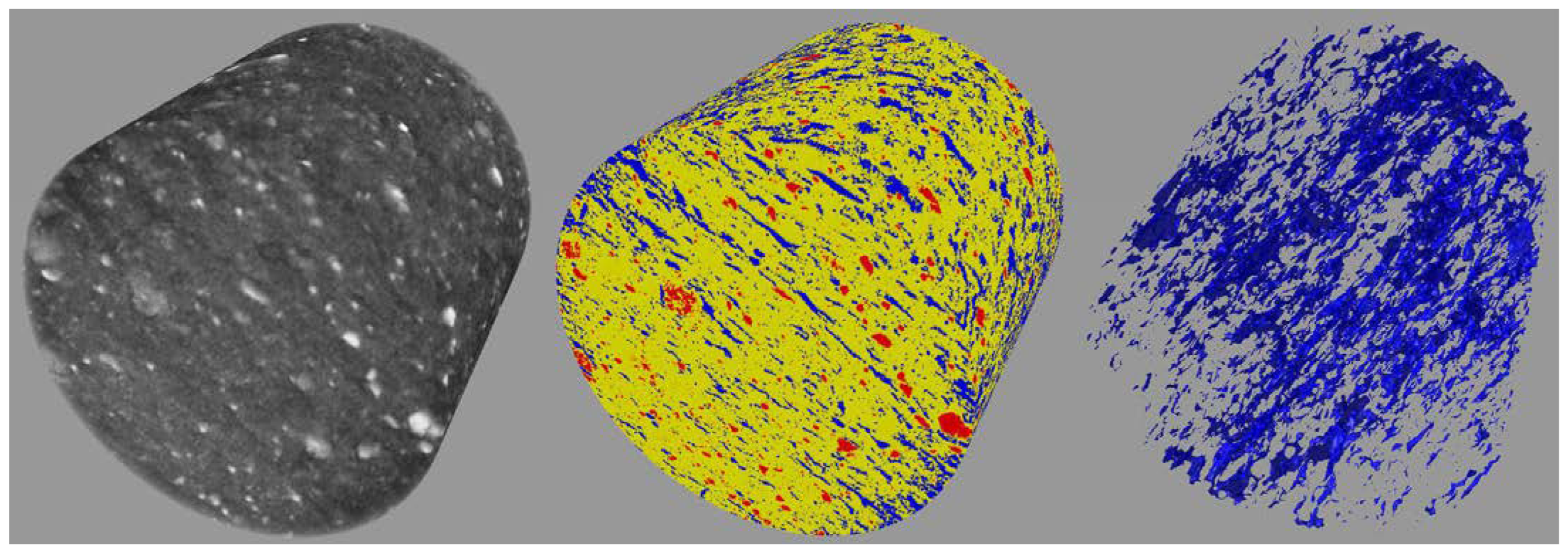




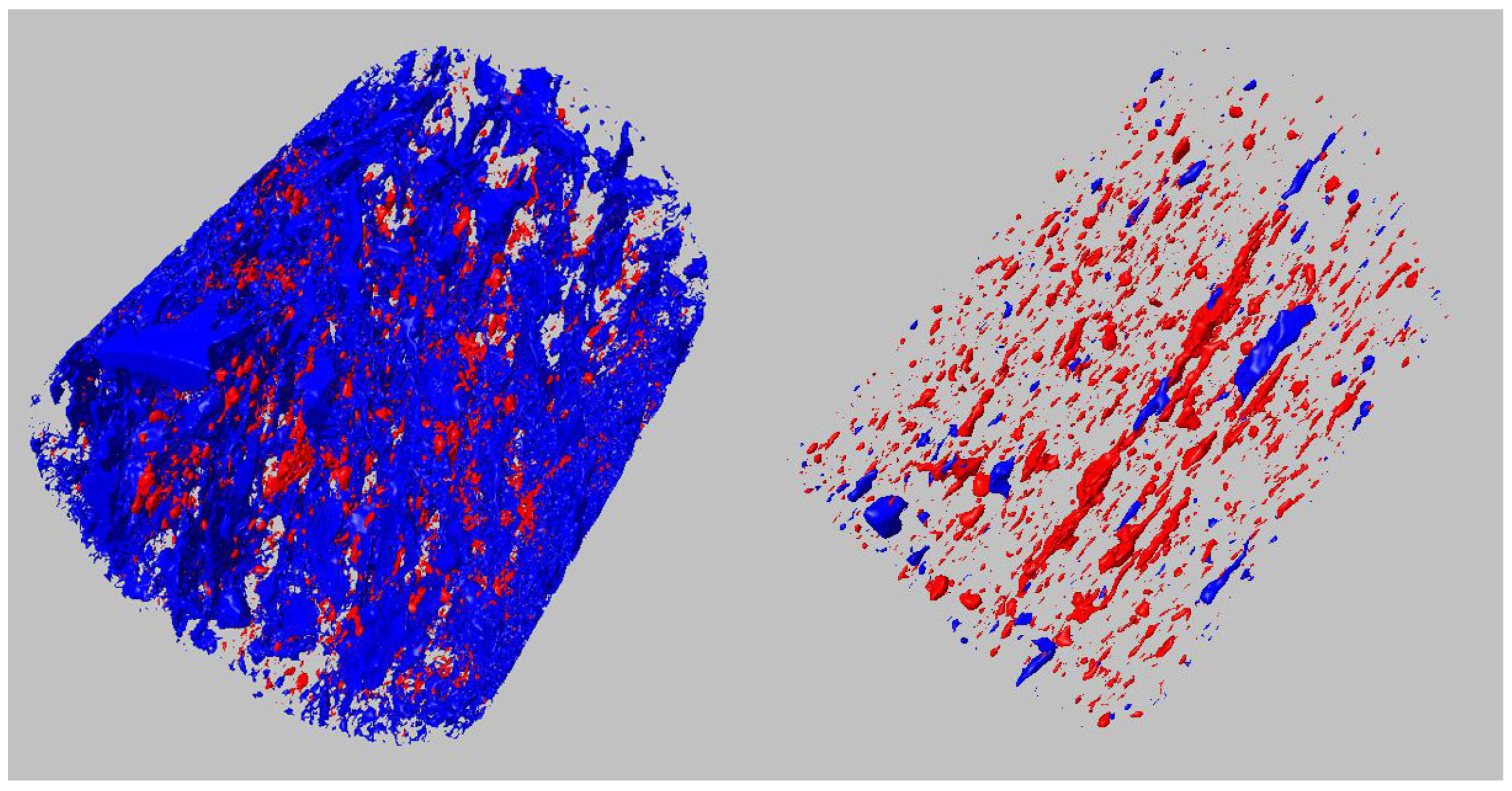
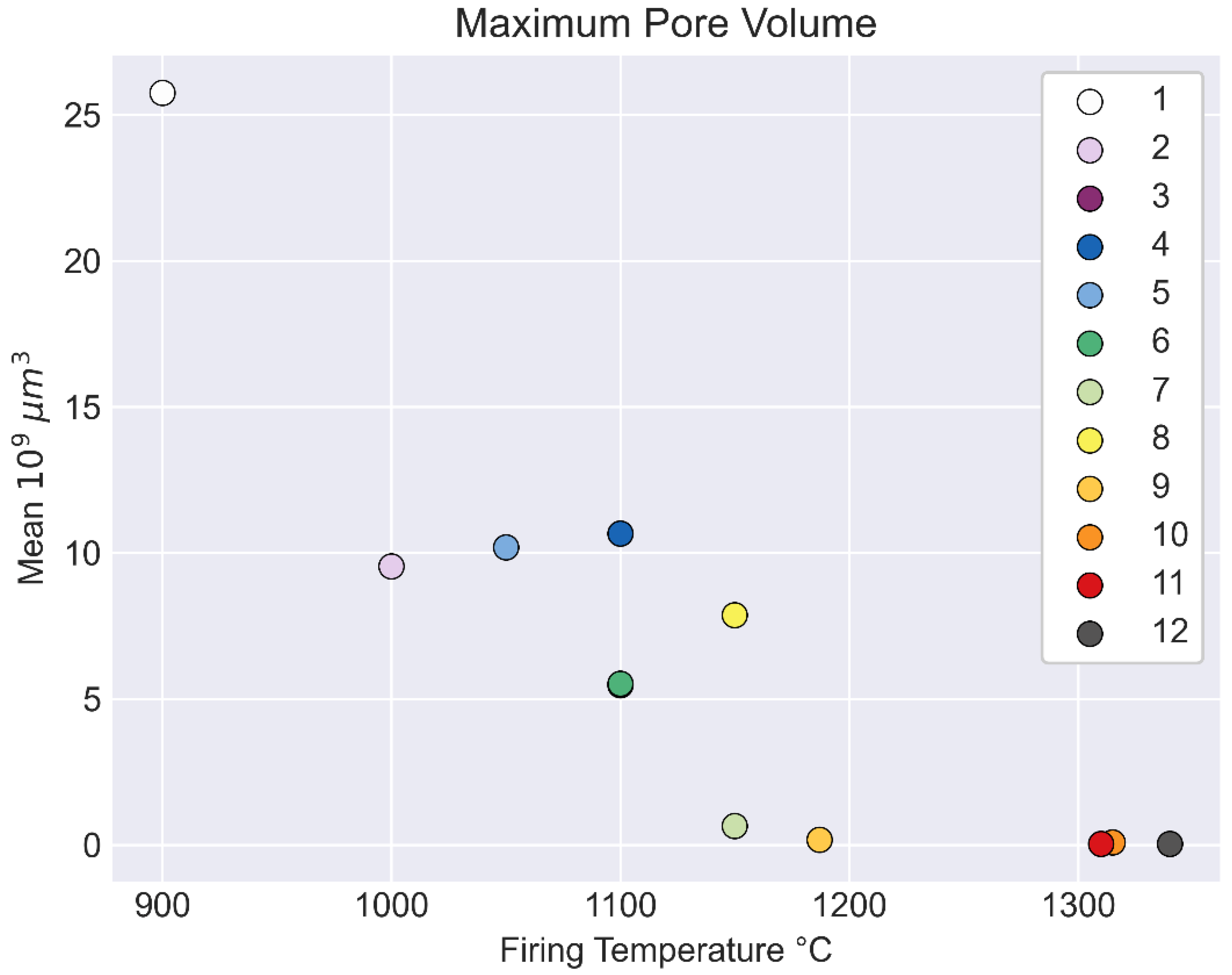
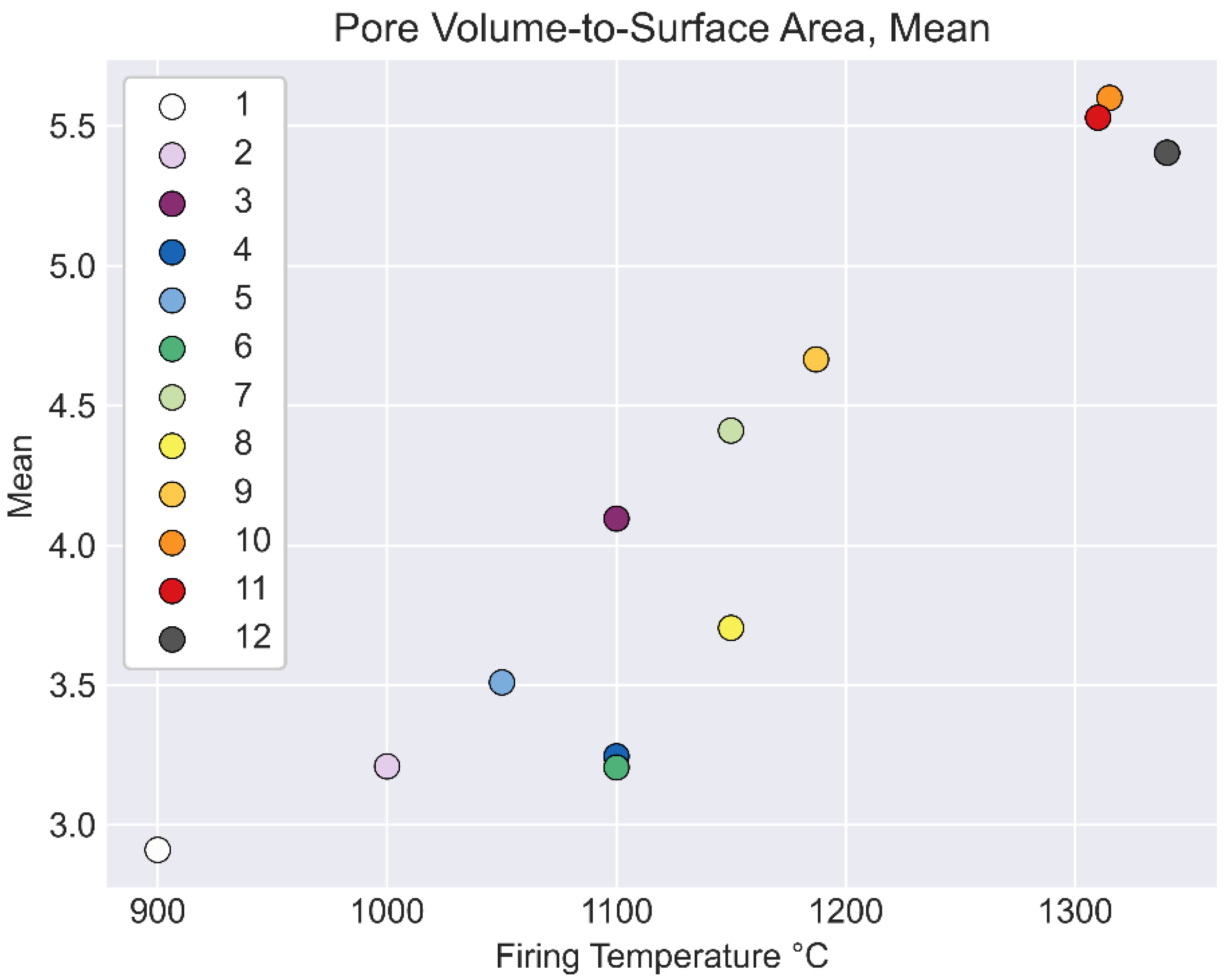

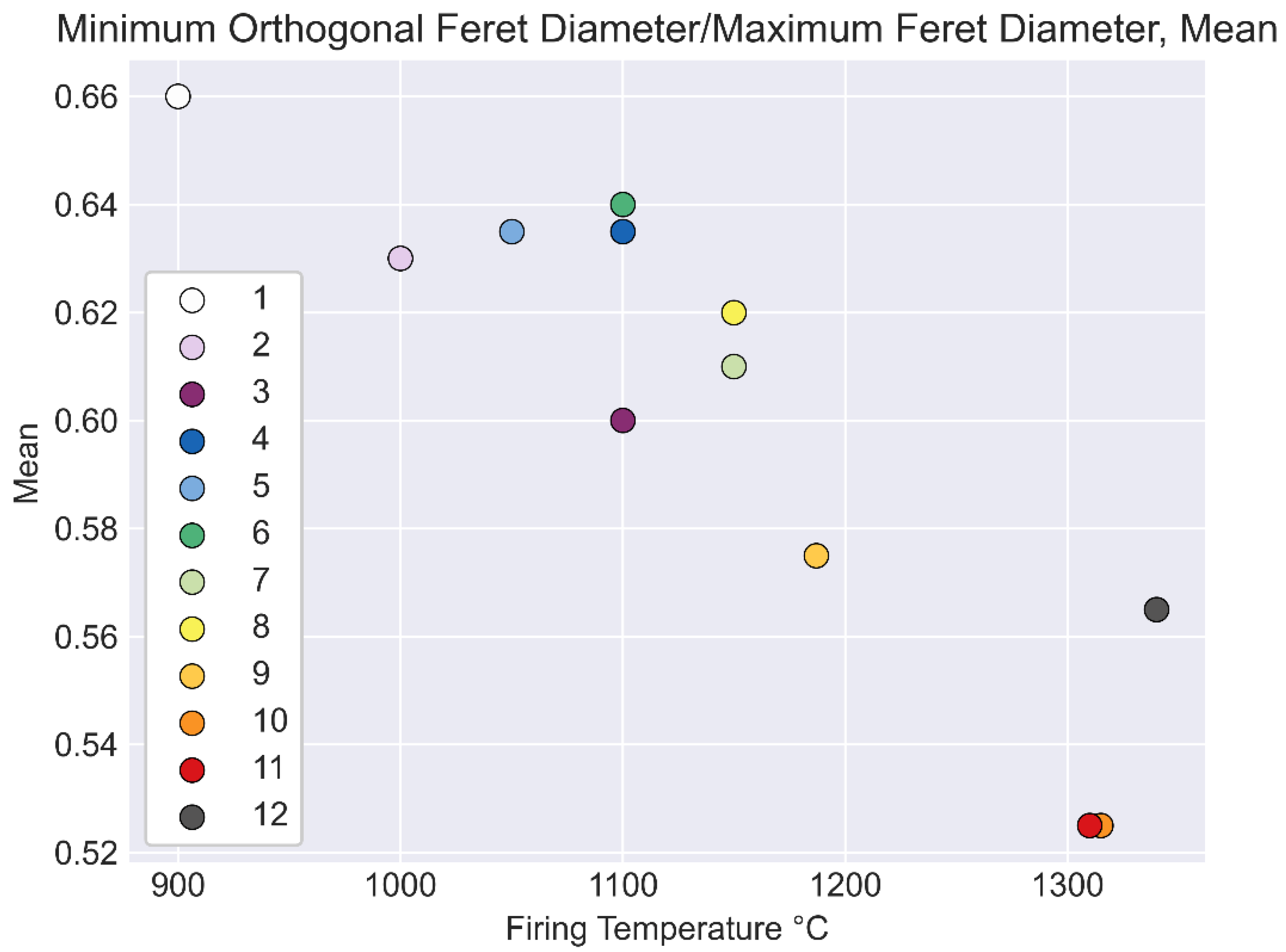
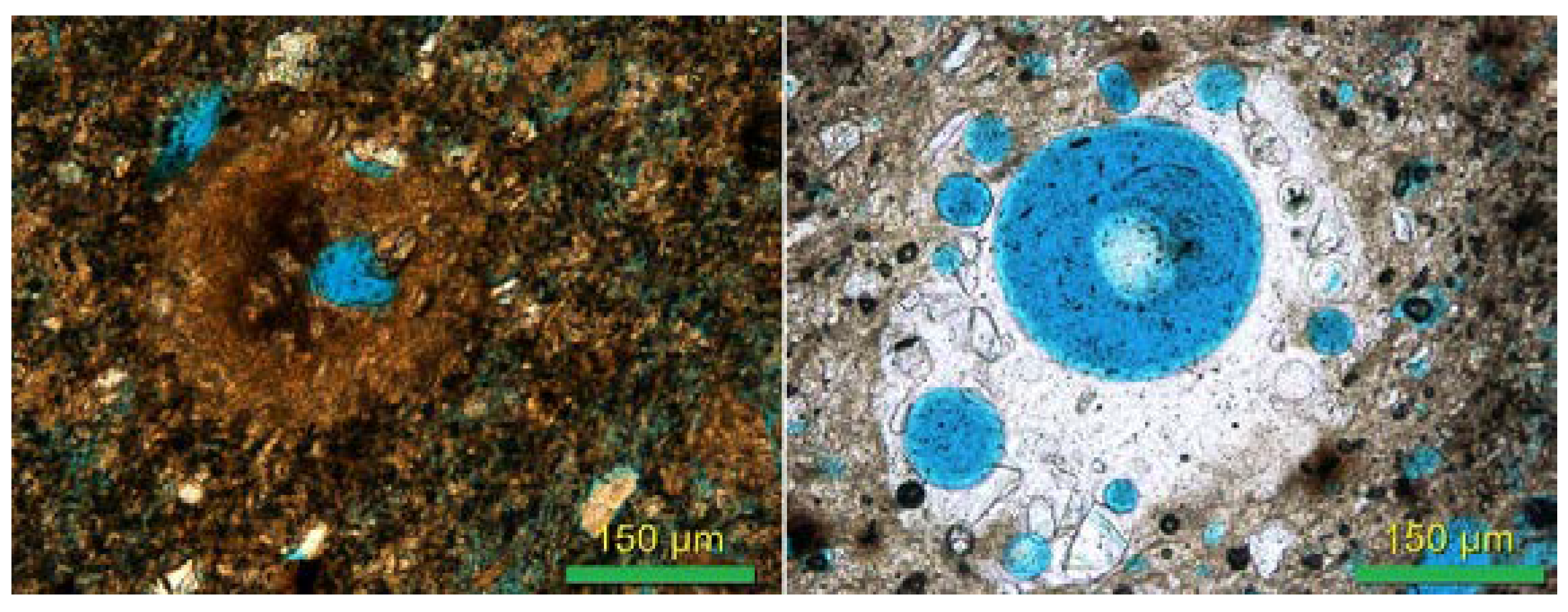
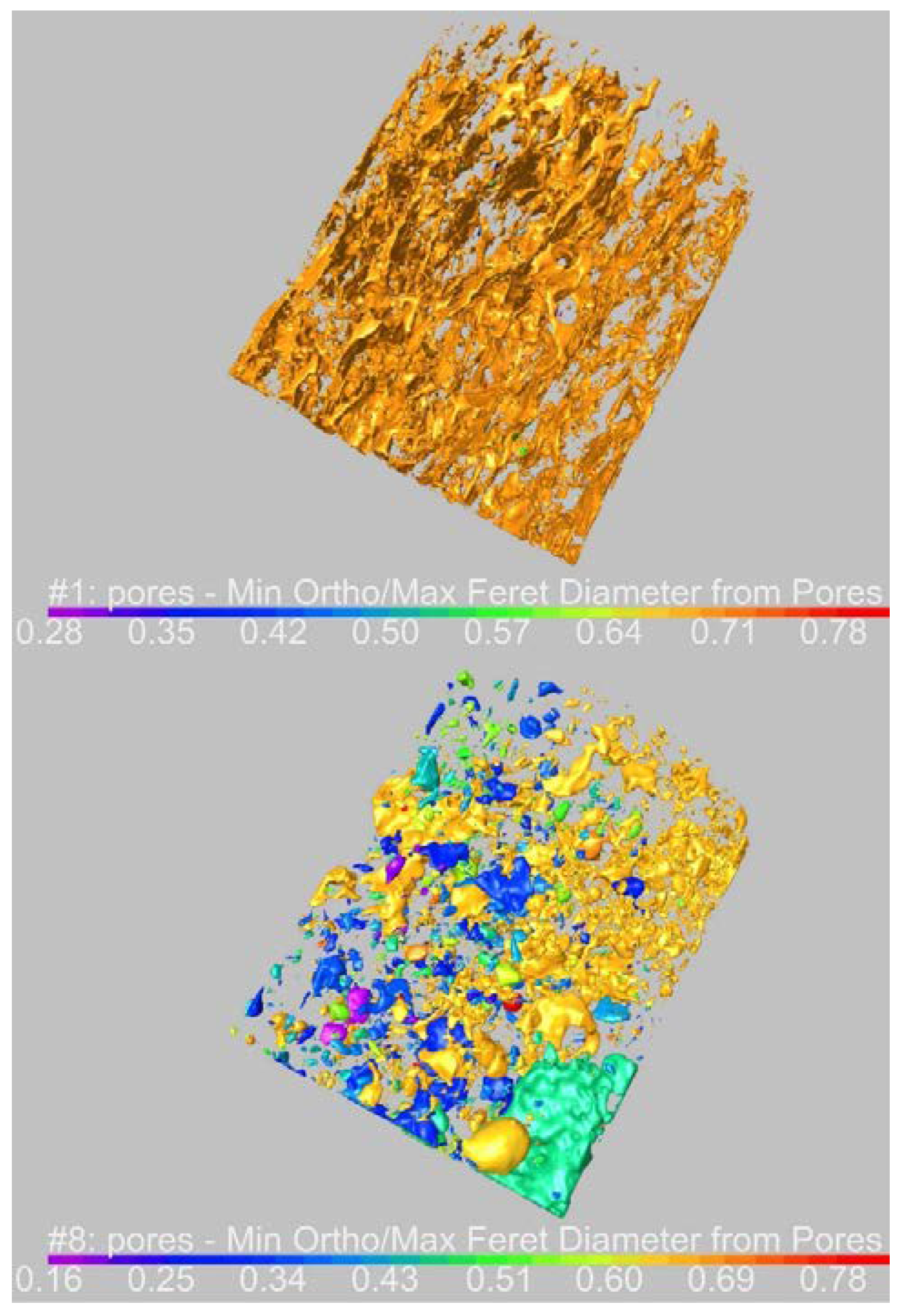
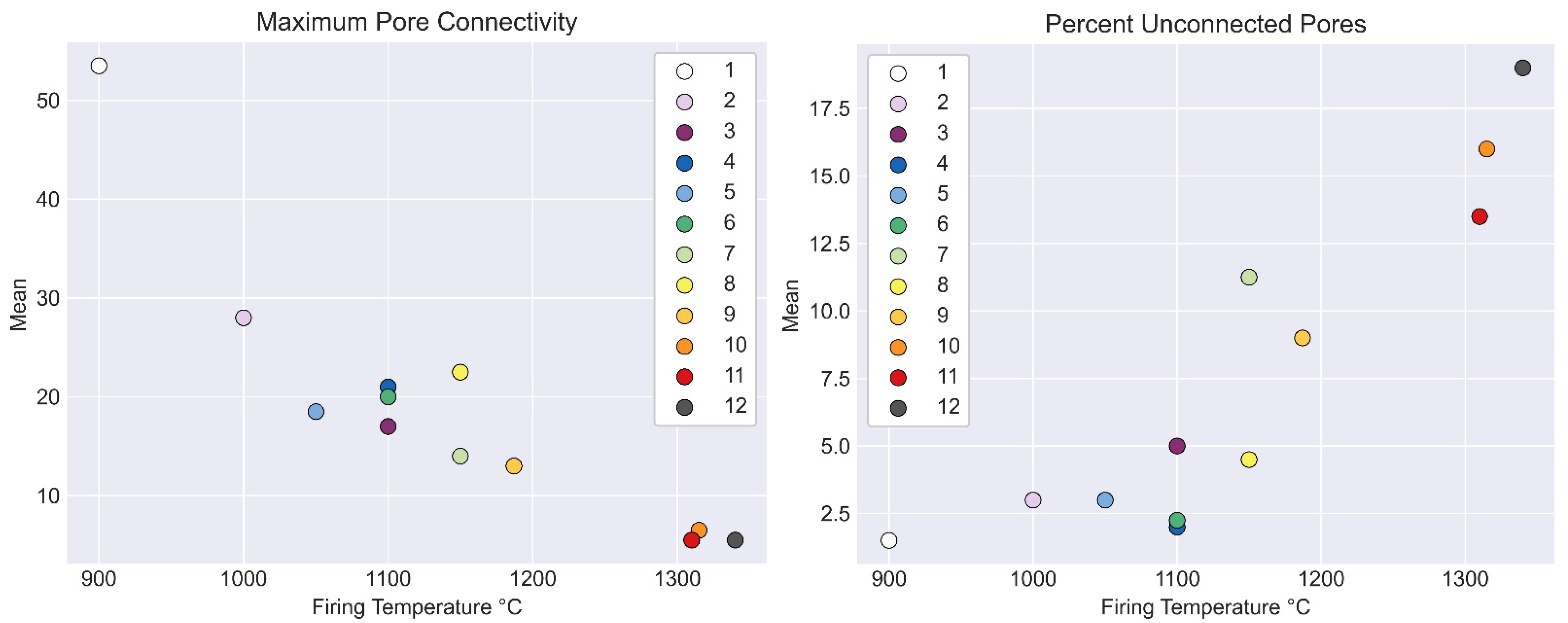
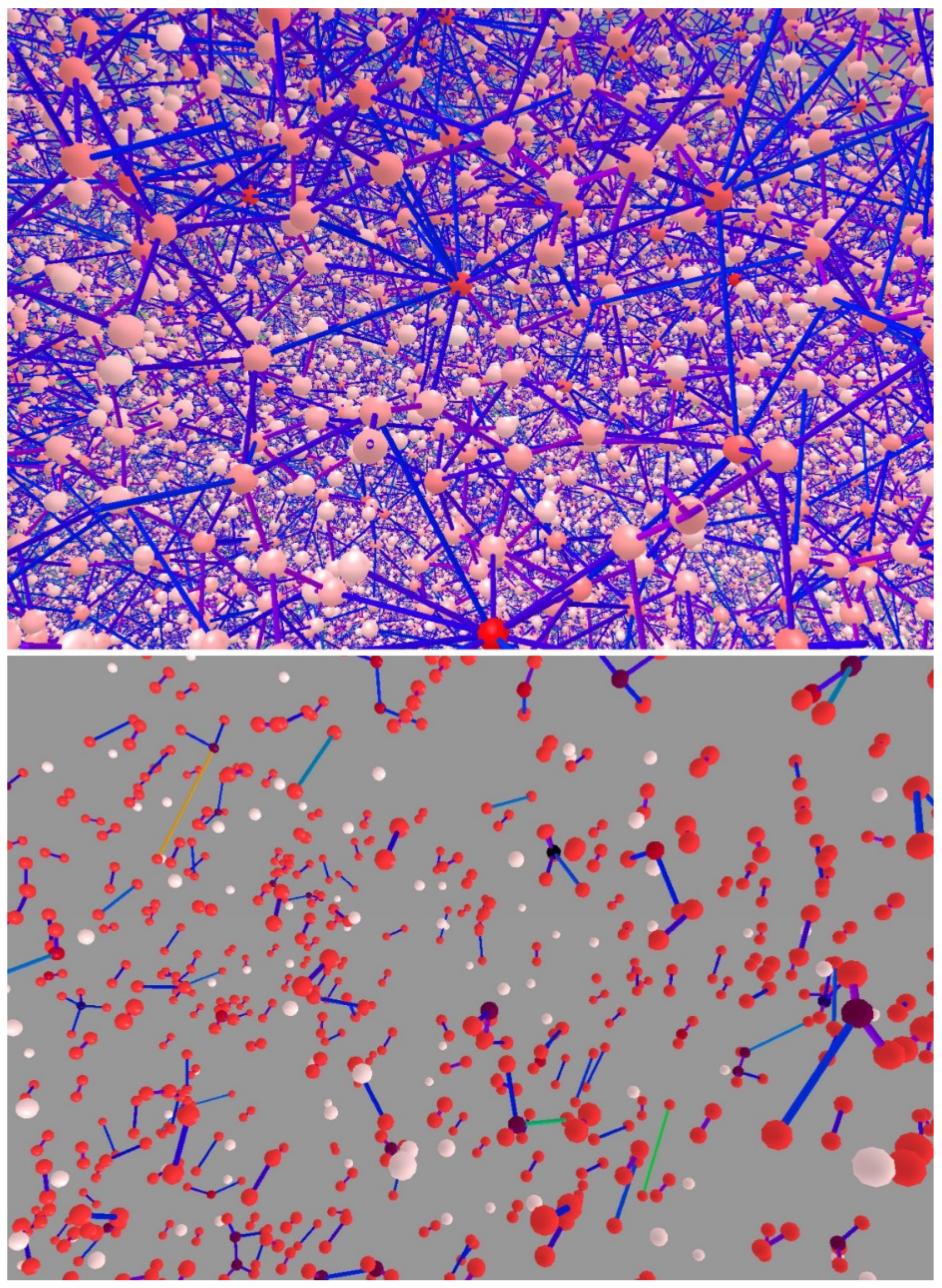

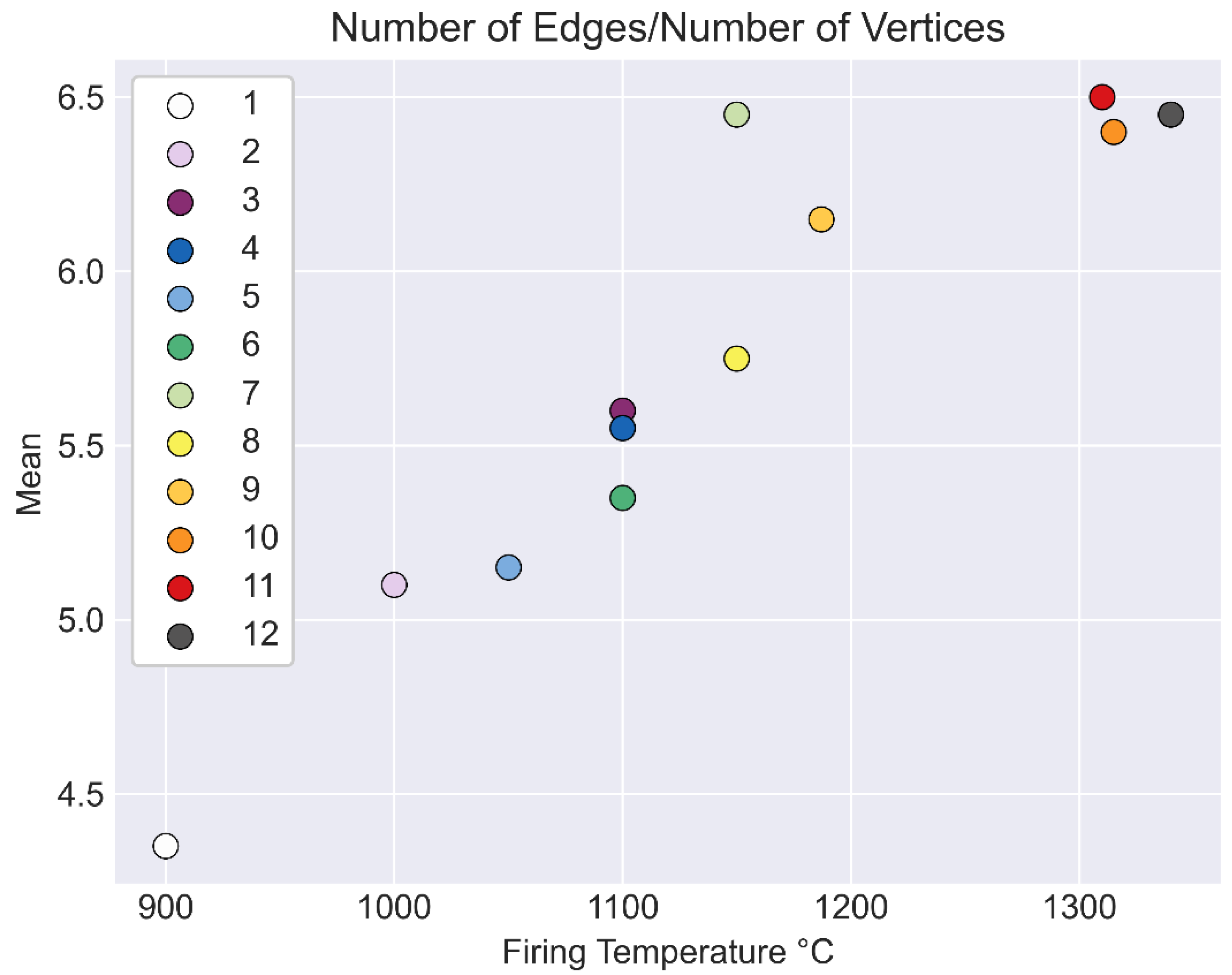

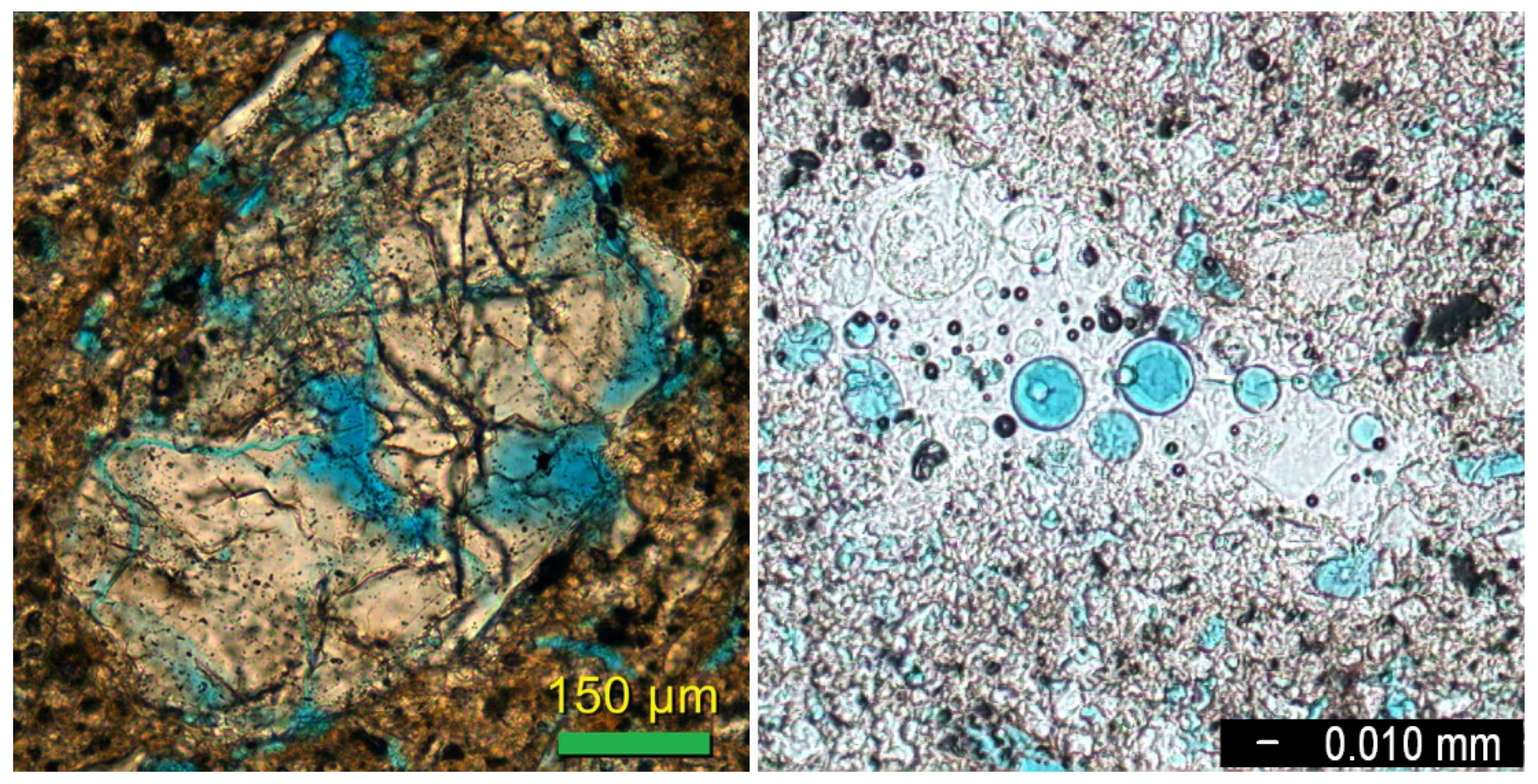
| Ceramic Type | Sherd Appearance | Firing Temperature |
|---|---|---|
|  | 900 °C [31] |
|  | 1000 °C [31] |
|  | 1000–1200 °C [53,54,55] |
|  | 1000–1200 °C [54,55,56] |
|  | 1050 °C [25] |
|  | 1050–1150 °C [26] |
|  | 1100–1200 °C [56,57,58,59,60] |
|  | 1150 °C [25] |
|  | 1150–1225 °C [61] |
|  | 1240–1390 °C [62] |
|  | 1300–1320 °C [63,64] |
|  | 1320–1380 °C [65] |
| Ceramic | Pore Volume % | % Surface Accessible | Ratio of Surface/ Interior Pores |
|---|---|---|---|
| 1 | 30.5 | 29.0 | 20.3 |
| 2 | 15.4 | 13.4 | 7.0 |
| 3 | 14.0 | 9.5 | 2.4 |
| 4 | 17.2 | 15.2 | 8.0 |
| 5 | 17.2 | 15.3 | 8.3 |
| 6 | 13.5 | 12.0 | 7.7 |
| 7 | 2.8 | 1.5 | 1.1 |
| 8 | 15.7 | 11.4 | 2.7 |
| 9 | 3.5 | 1.6 | 0.9 |
| 10 | 3.4 | 1.0 | 0.4 |
| 11 | 1.1 | 0.2 | 0.3 |
| 12 | 2.1 | 0.5 | 0.3 |
| Ceramic | Pore Volume % | % Surface Accessible | Ratio of Surface/ Interior Pores |
|---|---|---|---|
| 1 | 27.6 | 26.0 | 16.4 |
| 1 | 33.3 | 32.0 | 24.2 |
| 2 | 16.8 | 14.7 | 6.9 |
| 2 | 13.9 | 12.2 | 7.1 |
| 3 | 15.7 | 12.2 | 3.4 |
| 3 | 12.3 | 6.87 | 1.3 |
| 4 | 18.7 | 17.0 | 9.9 |
| 4 | 15.7 | 13.4 | 6.0 |
| 5 | 17.2 | 15.2 | 7.7 |
| 5 | 17.1 | 15.4 | 8.9 |
| 6 | 12.9 | 11.4 | 7.7 |
| 6 | 14.1 | 12.5 | 7.8 |
| 7 | 2.46 | 1.30 | 1.1 |
| 7 | 3.15 | 1.65 | 1.1 |
| 8 | 15.6 | 11.3 | 2.6 |
| 8 | 15.7 | 11.5 | 2.8 |
| 9 | 3.58 | 1.60 | 0.8 |
| 9 | 3.48 | 1.67 | 0.9 |
| 10 | 3.95 | 1.08 | 0.4 |
| 10 | 2.83 | 0.850 | 0.4 |
| 11 | 0.870 | 0.210 | 0.3 |
| 11 | 1.29 | 0.220 | 0.2 |
| 12 | 1.99 | 0.440 | 0.3 |
| 12 | 2.27 | 0.480 | 0.3 |
| No. | Volume Max 109 µm3 | Surface Area Max 108 µm2 | Surface Area SD 106 µm2 | Vol/Surface Area Mean µm | Vol/Surface Area SD µm | Aspect Ratio Mean | Mean Feret Diameter Mean µm | Max Feret Diameter Mean µm | Min Ortho Feret Diameter Mean µm | Min Ortho/Max Feret Diameter Mean µm |
|---|---|---|---|---|---|---|---|---|---|---|
| 1 | 25.8 | 17.5 | 4.72 | 2.91 | 1.05 | 0.140 | 30.1 | 36.2 | 20.9 | 0.660 |
| 2 | 9.54 | 5.66 | 1.96 | 3.21 | 1.36 | 0.175 | 35.3 | 42.6 | 23.4 | 0.630 |
| 3 | 5.47 | 2.87 | 1.35 | 4.10 | 2.43 | 0.225 | 51.2 | 62.2 | 31.2 | 0.600 |
| 4 | 10.7 | 8.49 | 3.45 | 3.25 | 1.45 | 0.160 | 37.5 | 45.4 | 23.8 | 0.635 |
| 5 | 10.2 | 5.39 | 2.69 | 3.51 | 1.81 | 0.190 | 39.6 | 48.3 | 26.4 | 0.635 |
| 6 | 5.52 | 4.21 | 2.07 | 3.21 | 1.40 | 0.165 | 35.8 | 44.6 | 24.3 | 0.640 |
| 7 | 0.644 | 0.498 | 0.353 | 4.41 | 2.20 | 0.285 | 49.8 | 61.3 | 33.3 | 0.610 |
| 8 | 7.86 | 6.01 | 2.16 | 3.71 | 1.89 | 0.205 | 43.5 | 53.1 | 28.0 | 0.620 |
| 9 | 0.167 | 0.143 | 0.163 | 4.67 | 2.62 | 0.270 | 57.4 | 71.1 | 34.3 | 0.575 |
| 10 | 0.0873 | 0.0279 | 0.0574 | 5.60 | 2.84 | 0.315 | 68.0 | 85.1 | 38.7 | 0.525 |
| 11 | 0.0301 | 0.0106 | 0.0297 | 5.53 | 2.68 | 0.285 | 68.0 | 86.7 | 38.5 | 0.525 |
| 12 | 0.0273 | 0.0102 | 0.0222 | 5.41 | 2.23 | 0.335 | 60.7 | 73.4 | 37.7 | 0.565 |
| Ceramic | Pore Connectivity Max | Pore Connectivity Mean | Pore Connectivity SD | % of the Pores Unconnected |
|---|---|---|---|---|
| 1 | 53.5 | 2.92 | 2.03 | 1.5 |
| 2 | 28.0 | 2.13 | 1.59 | 3.0 |
| 3 | 17.0 | 1.86 | 1.34 | 5.0 |
| 4 | 21.0 | 2.39 | 1.56 | 2.0 |
| 5 | 18.5 | 2.19 | 1.50 | 3.0 |
| 6 | 20.0 | 2.24 | 1.55 | 2.3 |
| 7 | 14.0 | 1.60 | 1.39 | 11.3 |
| 8 | 22.5 | 2.24 | 1.65 | 4.5 |
| 9 | 13.0 | 1.47 | 1.17 | 9.0 |
| 10 | 6.5 | 1.06 | 0.760 | 16.0 |
| 11 | 5.5 | 0.985 | 0.605 | 13.5 |
| 12 | 5.5 | 0.925 | 0.640 | 19.0 |
| Ceramic | Pore Connectivity Max | Pore Connectivity Mean | Pore Connectivity SD | Segment Tortuosity Mean | Vertex Length SD | Edge Length SD |
|---|---|---|---|---|---|---|
| 1 | 64.5 | 2.23 | 1.10 | 1.25 | 50.4 | 38.1 |
| 2 | 32.0 | 2.06 | 0.835 | 1.26 | 58.7 | 47.7 |
| 3 | 17.0 | 1.97 | 0.680 | 1.25 | 63.9 | 53.1 |
| 4 | 27.0 | 2.10 | 0.790 | 1.24 | 50.7 | 38.8 |
| 5 | 19.5 | 2.05 | 0.730 | 1.27 | 60.7 | 49.6 |
| 6 | 22.5 | 2.07 | 0.810 | 1.25 | 49.9 | 38.3 |
| 7 | 16.0 | 1.88 | 0.810 | 1.24 | 52.7 | 40.7 |
| 8 | 24.5 | 2.07 | 0.860 | 1.25 | 52.6 | 40.8 |
| 9 | 13.0 | 1.85 | 0.695 | 1.25 | 64.5 | 54.2 |
| 10 | 6.5 | 1.71 | 0.610 | 1.24 | 77.7 | 66.9 |
| 11 | 5.5 | 1.65 | 0.600 | 1.17 | 94.1 | 87.2 |
| 12 | 6.0 | 1.55 | 0.675 | 1.18 | 61.3 | 53.1 |
| Ceramic | Ratio of # of Edges/# of Vertices | Edge Equivalent Diameter Mean, µm | Vertex Equivalent Diameter Mean, µm |
|---|---|---|---|
| 1 | 4.35 | 127 | 235 |
| 2 | 5.10 | 129 | 239 |
| 3 | 5.60 | 120 | 232 |
| 4 | 5.55 | 119 | 235 |
| 5 | 5.15 | 125 | 240 |
| 6 | 5.35 | 122 | 232 |
| 7 | 6.45 | 155 | 308 |
| 8 | 5.75 | 120 | 234 |
| 9 | 6.15 | 163 | 324 |
| 10 | 6.40 | 146 | 292 |
| 11 | 6.50 | 182 | 363 |
| 12 | 6.45 | 150 | 302 |
Publisher’s Note: MDPI stays neutral with regard to jurisdictional claims in published maps and institutional affiliations. |
© 2022 by the authors. Licensee MDPI, Basel, Switzerland. This article is an open access article distributed under the terms and conditions of the Creative Commons Attribution (CC BY) license (https://creativecommons.org/licenses/by/4.0/).
Share and Cite
Reedy, C.L.; Reedy, C.L. Micro-Computed Tomography with 3D Image Analysis to Reveal Firing Temperature Effects on Pore Systems in Archaeological and Ethnographic Ceramics. Appl. Sci. 2022, 12, 11448. https://doi.org/10.3390/app122211448
Reedy CL, Reedy CL. Micro-Computed Tomography with 3D Image Analysis to Reveal Firing Temperature Effects on Pore Systems in Archaeological and Ethnographic Ceramics. Applied Sciences. 2022; 12(22):11448. https://doi.org/10.3390/app122211448
Chicago/Turabian StyleReedy, Chandra L., and Cara L. Reedy. 2022. "Micro-Computed Tomography with 3D Image Analysis to Reveal Firing Temperature Effects on Pore Systems in Archaeological and Ethnographic Ceramics" Applied Sciences 12, no. 22: 11448. https://doi.org/10.3390/app122211448
APA StyleReedy, C. L., & Reedy, C. L. (2022). Micro-Computed Tomography with 3D Image Analysis to Reveal Firing Temperature Effects on Pore Systems in Archaeological and Ethnographic Ceramics. Applied Sciences, 12(22), 11448. https://doi.org/10.3390/app122211448







